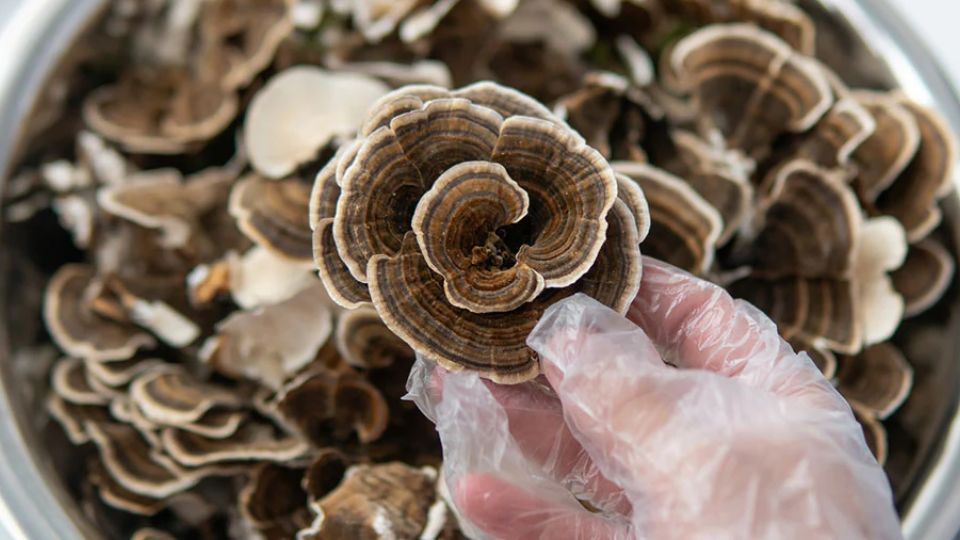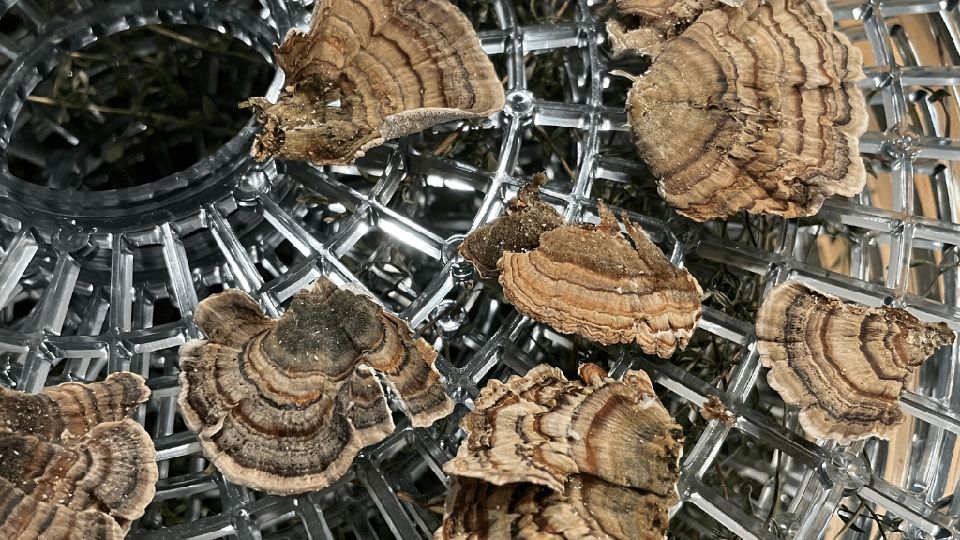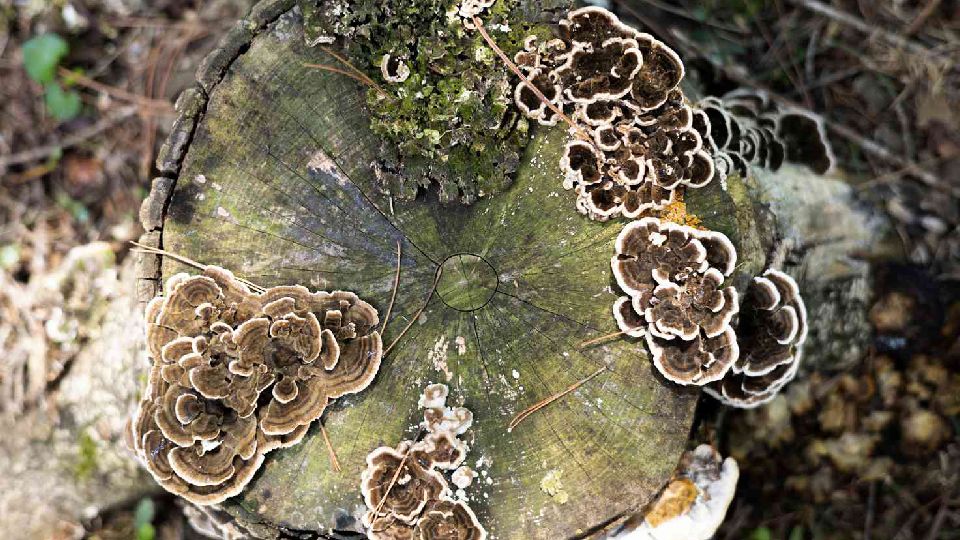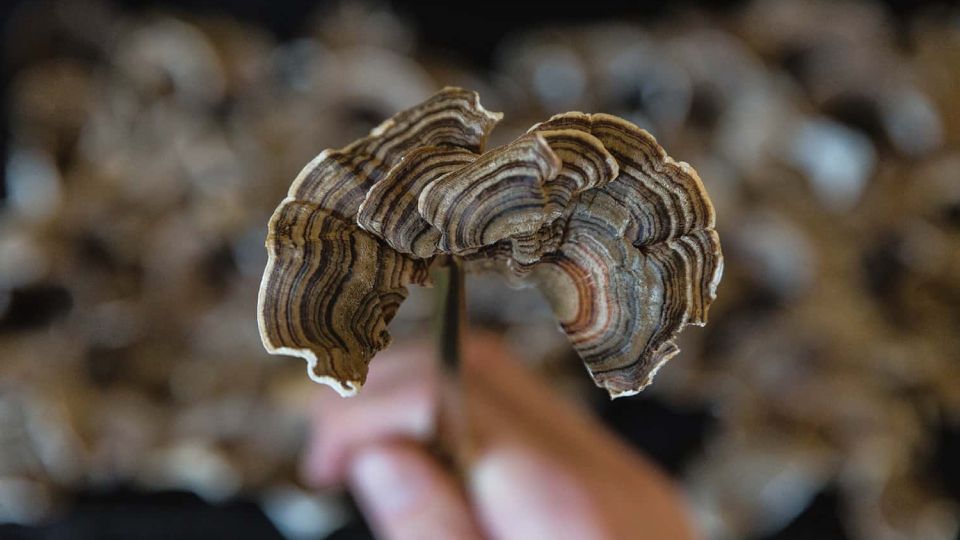How to Dry Turkey Tail Mushrooms: All You Need to Know
As mushroom enthusiasts and foraging enthusiasts, we’re always on the lookout for unique and beneficial fungi. These beautiful fan-shaped fungi, scientifically known as Trametes versicolor, truly captivate with their unique appearance and impressive medicinal properties. In Eastern medicine, they are known as Yun Zhi in China or Kawaratake in Japan, underlining their significance in traditional healing practices.
Since the 1950s, doctors and scientists in Asia have noticed remarkable benefits in cancer patients who consumed turkey tail tea. They observed reduced tumor growth and, in some cases, even tumor shrinkage[1]. Notably, these mushrooms also appear to boost the immune system and aid in faster recovery from challenging treatments like chemotherapy and radiation[2].
Drying turkey tail mushrooms is an excellent way to preserve your foraging harvest and make the most of your mushroom-hunting adventures. If you’re a beginner, we completely understand that the process might seem a bit overwhelming. But fear not! We’re here to guide you through the simple steps of drying turkey tail mushrooms, so you can enjoy safe and delicious dried mushrooms later on.
In this article:
Why Dry or Dehydrate Turkey Tail Mushrooms?
Drying turkey tail mushrooms is an excellent way to preserve their nutrients and medicinal properties for an extended period. The beauty of dried mushrooms lies in their convenience. You can easily reconstitute them by soaking them in water for a few hours. This makes them perfect for camping or hiking trips since they are lightweight and easy to carry.
Moreover, drying mushrooms helps retain their flavor and prevents spoilage. When dried, these mushrooms can be used in various culinary creations, such as soups, stews, teas, coffees, and juices, allowing you to enjoy their benefits year-round. You can even rehydrate them to use as delicious pizza toppings or in savory creations.
For the best outcome, you can either use a food dehydrator or set your oven to the lowest temperature. This way, you can preserve their texture and taste. To prevent sticking, simply use a mesh screen or cheesecloth on the dehydrator tray. Remember to dry the mushrooms thoroughly until they become crisp to avoid any potential molding or spoilage during storage.
Preparing Turkey Tail Mushrooms for Drying
Once you’ve harvested a bountiful supply of turkey tail mushrooms, it’s crucial to prepare them properly before drying. The preparation process involves cleaning, inspecting, and potentially slicing the mushrooms to ensure they dry evenly and efficiently.
Clean the mushrooms by brushing off any dirt or debris with a soft brush or cloth. Avoid using water, as mushrooms are porous and can absorb moisture, which may lead to spoilage during the drying process. Inspect the mushrooms carefully to remove any remaining debris or insects, ensuring only fresh and clean mushrooms are prepared for drying.
How to Dry Fresh Turkey Tail Mushrooms

To dry Turkey tail mushrooms, first, begin by carefully removing the skin from the tail using a sharp knife or a scissor. Then, cut the tail into smaller, inch-wide sections. Now, it’s time to start drying them.
Below, we discuss four common drying methods:
1. Air Drying
Air drying is the simplest method and requires no special equipment. These mushrooms are well-suited for air drying since they are thin and uniform in size. Simply place the mushrooms on a clean, dry surface in a well-ventilated area. Avoid direct sunlight, as it may cause nutrient degradation. Allow the mushrooms to dry completely for several days until they become crisp and brittle. Usually, it’ll take 1-2 weeks.
2. Using a Dehydrator
A dehydrator is an excellent option for more controlled drying. Follow the manufacturer’s instructions to set the dehydrator to a low temperature (around 100°F or 38°C). Arrange the cleaned and sliced mushrooms on the dehydrator trays, making sure to leave space between each piece for proper air circulation. Check the mushrooms regularly, dry for 12-24 hours, or until the mushrooms are crisp, and once they are fully dried, store them in an airtight container.
3. Oven Drying
If you don’t have a dehydrator, you can use your oven to dry turkey tail mushrooms. Set the oven to the lowest possible temperature (around 150°F or 65°C). Place the cleaned and sliced mushrooms on a baking sheet lined with parchment paper. Prop open the oven door slightly to allow moisture to escape. Bake for 1-2 hours, regularly check the mushrooms until they are fully dried.
4. Solar Drying
Solar drying is an eco-friendly method that harnesses the sun’s natural heat to dry mushrooms. It requires a sunny and warm day. You can dry mushrooms in the sun by placing them on a screen or rack in a sunny spot. Let them dry for 1-2 days, but keep an eye on them to prevent overdrying in direct sunlight.
Drying mushrooms this way helps prevent spoilage and preserves their flavor. Before storing them, ensure that your mushrooms are completely dry. This will ensure they stay fresh and ready for later use.
How to Use Dried Turkey Tail Mushrooms

Here are 6 ways to use dried turkey tail mushrooms. Try each method to discover the one that best suits your preferences and needs.
1. Making Turkey Tail Tea
To prepare turkey tail tea, take one cup of dried turkey tail mushrooms or powdered turkey tail supplements and add them to five cups of water. Simmer the mixture until the water reduces to one cup of concentrated turkey tail tea. Strain out the mushrooms, and your tea is ready to enjoy!
Read More: How To Make Turkey Tail Tea
2. Using Turkey Tail Powder
You can easily create a versatile turkey tail mushroom powder by blending dried mushrooms in a food blender. This powder will provide a great nutritional boost when added to your favorite beverages or recipes, such as teas, coffees, smoothies, or soups. Simply spoon in some powder, mix it in, and enjoy the benefits of this wholesome addition.
3. Taking Turkey Tail Capsules
If you prefer capsules, you can find turkey tail mushroom supplements in this form. Follow the manufacturer’s recommended dosage instructions when taking these capsules.
4. Cooking with Turkey Tail Mushrooms
Turkey tail mushrooms have a savory flavor and chewy texture, ideal for soups and broths. Soak dried turkey tail mushrooms in warm water until softened, then simmer them with other mushrooms for a flavorful broth. You can also add dried mushroom powder to smoothies, oatmeal, soups, or salad dressings for added taste and nutrition.
5. Making Turkey Tail Tincture
Turkey tail tincture is a powerful blend of turkey tail mushrooms, created through two distinct processes: alcohol extraction and hot water extraction. These tinctures have a long history of medicinal use, offering the benefits of turkey tail mushrooms for extended periods. You can easily incorporate the tincture into your daily routine by adding it to your morning tea or coffee or taking it directly under your tongue.
Making a turkey tail tincture might sound daunting, but it’s simpler than you might expect. Just keep in mind that tinctures require some time to develop fully. Typically, the turkey tail mushrooms need to sit in alcohol for 4-8 weeks before moving on to the hot water extraction stage. Though it takes patience, we believe the result is well worth the wait.
6. Trying Turkey Tail Gummies
For a convenient and tasty option, you can try turkey tail mushroom gummies. These gummies usually contain turkey tail mushroom extract and are a great way to incorporate turkey tail into your routine. Just follow the recommended dosage provided by the manufacturer.
Remember, before making any significant changes to your diet or starting a new supplement, it’s essential to consult with a healthcare professional for personalized advice and guidance.
Shelf Life of Dried Turkey Tail Mushrooms
Dried turkey tail mushrooms have a long shelf life when stored correctly. Keep them in an airtight container, in a cool, dry place for up to two years. This way, the mushrooms will retain their flavor and potency. However, avoid exposing them to moisture or light, as they can quickly deteriorate. Regularly inspect the stored mushrooms for any signs of mold or spoilage. If you notice any, discard the affected mushrooms to prevent contamination.
To ensure their quality, store the mushrooms in a dark, cool location with stable temperatures and low humidity. By following these storage guidelines, you can enjoy the deliciousness of dried turkey tail mushrooms for many months or even years.
How to Identify Turkey Tail Mushrooms
Identifying Turkey Tail mushrooms in the wild becomes easier when we focus on four key characteristics. First, let’s check the mushroom’s thickness, examine its color patterns, and observe the pore pattern underneath. Additionally, feel the top surface for a velvety texture.
Turkey Tail mushrooms resemble a turkey’s tail, displaying distinct and eye-catching color patterns. These mushrooms are commonly found on fallen logs and tree stumps. The great thing about turkey tail mushrooms is that they can grow and be harvested throughout the year!
However, we should be cautious of the false turkey tail (Stereum ostrea), which bears a striking resemblance to the real turkey tail. To differentiate between the two, look at the underside: the false turkey tail will seem smooth, while the real turkey tail will have small but visible pores.
When handling a true turkey tail mushroom, it should have a thin and flexible body. If the mushroom feels rigid, it might belong to a different species.
Remember to look for the soft velvet-like texture on the top surface as well, this can help confirm that you’ve found the right turkey tail mushroom.
Harvesting Turkey Tail Mushrooms

Before drying turkey tail mushrooms, it’s essential to learn the proper harvesting techniques. You can easily grow turkey tail mushrooms at home or forage them in the wild. Creating the right conditions and following proper steps will make cultivating them at home a rewarding and fascinating experience.
While they are commonly found in the wild, these mushrooms can be found growing on dead hardwood logs, stumps, and branches in wooded areas. The best time for harvesting is typically in the late summer or early fall when they are at their peak.
These mushrooms prefer cooler temperatures and thrive in humid environments, making North America an ideal region for their growth. When foraging, look for mature specimens with distinct color bands, and avoid those that appear damaged or decayed. Gently cut the mushrooms at the base with a knife or a scissor, ensuring not disturb the surrounding habitat. It’s essential to identify turkey tail mushrooms accurately to avoid potential look-alikes.
What Are The Health Benefits of Turkey Tail Mushrooms?
Turkey tail mushrooms offer a wide range of potential benefits that researchers are actively studying for various applications. Some of these benefits include:
- Immune-Boosting: Packed with antioxidants and immune-boosting polysaccharopeptides.
- Cancer Treatment Support: May slow cancer growth and enhance response to cancer treatments.
- Reduced Inflammation: Promotes a healthy inflammation response.
- Improved Insulin Resistance: Shows potential for improving insulin resistance.
- Enhanced Cognitive Function: May improve cognitive function.
- Increased Exercise Performance: It could boost exercise performance.
- Lower Blood Sugar: It may help lower blood sugar in type 2 diabetes[4].
More research is needed to fully understand the effects. Consult a healthcare professional before use.
Safety and Considerations
While turkey tail mushrooms offer numerous health benefits, it’s essential to take safety precautions when foraging and handling them. Here are some vital safety tips:
- Always consult a local mycologist or expert in mushroom identification before foraging.
- Never consume mushrooms unless you are certain of their identity, as some toxic mushrooms can look similar to turkey tail mushrooms.
- Avoid foraging in areas where pollution or chemical contamination is possible.
- Cook turkey tail mushrooms thoroughly before consumption to eliminate any potential risks.
- If you plan to use turkey tail mushroom supplements or extracts, consult with a healthcare professional, especially if you have any existing health conditions or are taking medications.
FAQs
How to Prepare Turkey Tail Mushrooms For Medicinal Purposes?
To prepare turkey tail mushrooms for medicinal purposes, first, ensure they are clean and free of debris. Then, gently dry them by placing them on a paper towel in a well-ventilated area. Finally, grind or steep as needed for the desired use.
What Temperature Do You Dry Turkey Tail Mushrooms?
To dry Turkey Tail mushrooms, use a food dehydrator or an oven set to its lowest temperature, around 130-140°F (54-60°C). Spread the mushrooms evenly on trays or a baking sheet and leave them for several hours until they’re dry and crisp. Ensure good ventilation for best results.
How To Make Tea With Dried Turkey Tail Mushrooms?
To make tea with dried Turkey Tail mushrooms, simply simmer 1-2 dried slices in hot water for about 20 minutes. Then, strain the liquid into a cup, and it’s ready to enjoy. You can add honey or lemon for extra flavor. This tea is known for its potential health benefits.
How Do You Harvest Turkey Tail Mushrooms?
To harvest Turkey Tail mushrooms, use a knife or scissors to cut them at the base, leaving a small portion attached. This allows for regrowth. Be sure they’re firm and in good condition. Harvest when they’re young and tender, usually in late summer or fall. Always follow ethical foraging guidelines.
Conclusion
Now you know all the essentials of drying wild turkey tail mushrooms. It’s not a challenging task, but you must take precautions to prevent spoilage and contamination. By following these simple steps, you’ll ensure your dried mushrooms are safe to eat and offer numerous health benefits.
References
1. Improved production and antitumor activity of intracellular protein-polysaccharide from Trametes versicolor by the quorum sensing molecule-tyrosol. Retrieved from https://www.researchgate.net/publication/318752626_Improved_production_and_antitumor_activity_of_intracellular_protein-polysaccharide_from_Trametes_versicolor_by_the_quorum_sensing_molecule-tyrosol
2. Coriolus (Trametes) versicolor mushroom to reduce adverse effects from chemotherapy or radiotherapy in people with colorectal cancer. Retrieved from https://www.researchgate.net/publication/365843743_Coriolus_Trametes_versicolor_mushroom_to_reduce_adverse_effects_from_chemotherapy_or_radiotherapy_in_people_with_colorectal_cancer
3. Trametes versicolor extract modifies human fecal microbiota composition in vitro. Retrieved from https://pubmed.ncbi.nlm.nih.gov/23435630/
4. Anti-diabetic Effect of Methanol Extract of Trametes versicolor on Male Mice. Retrieved from https://www.researchgate.net/publication/316512004_Anti-diabetic_effect_of_methanol_extract_of_Trametes_versicolor_on_male_mice?_sg=EnfbcYjjs3zFMxlBxBYDc8vZ90wLO-UrmlyoGYX7p4vDApEUvCNDS6vR0-ynU-VfNQPpl6L9tQte6Fc

